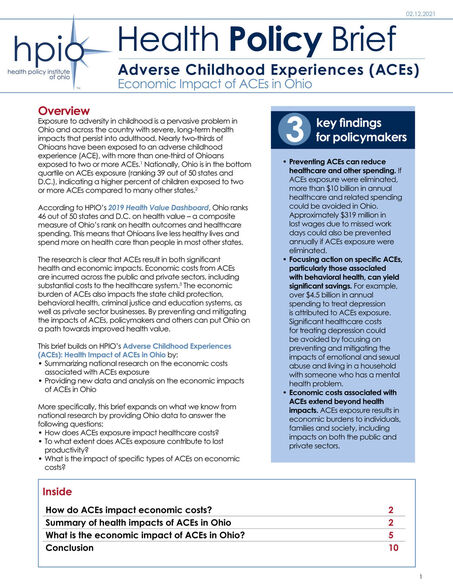Adverse Childhood Experiences (ACEs):
Economic Impact of ACEs in Ohio
Exposure to adversity in childhood is a pervasive problem in Ohio and across the country with severe, long-term health impacts that persist into adulthood. Nearly two-thirds of Ohioans have been exposed to an adverse childhood experience (ACE), with more than one-third of Ohioans exposed to two or more ACEs.1 Nationally, Ohio is in the bottom quartile on ACEs exposure (ranking 39 out of 50 states and D.C.), indicating a higher percent of children exposed to two or more ACEs compared to many other states.2
According to HPIO’s 2019 Health Value Dashboard, Ohio ranks 46 out of 50 states and D.C. on health value – a composite measure of Ohio’s rank on health outcomes and healthcare spending. This means that Ohioans live less healthy lives and spend more on health care than people in most other states.
The research is clear that ACEs result in both significant health and economic impacts. Economic costs from ACEs are incurred across the public and private sectors, including substantial costs to the healthcare system.3 The economic burden of ACEs also impacts the state child protection, behavioral health, criminal justice and education systems, as well as private sector businesses. By preventing and mitigating the impacts of ACEs, policymakers and others can put Ohio on a path towards improved health value.
This brief builds on HPIO’s Adverse Childhood Experiences (ACEs): Health Impact of ACEs in Ohio by:
- Summarizing national research on the economic costs associated with ACEs exposure
- Providing new data and analysis on the economic impacts of ACEs in Ohio
More specifically, this brief expands on what we know from national research by providing Ohio data to answer the following questions:
- How does ACEs exposure impact healthcare costs?
- To what extent does ACEs exposure contribute to lost productivity?
- What is the impact of specific types of ACEs on economic costs?
Downloads
- Facts & Figures (PowerPoint data graphics from the report for public use)
3 Key findings for policymakers
- Preventing ACEs can reduce healthcare and other spending. If ACEs exposure were eliminated, more than $10 billion in annual healthcare and related spending could be avoided in Ohio. Approximately $319 million in lost wages due to missed work days could also be prevented annually if ACEs exposure were eliminated.
- Focusing action on specific ACEs, particularly those associated with behavioral health, can yield significant savings. For example, over $4.5 billion in annual spending to treat depression is attributed to ACEs exposure. Significant healthcare costs for treating depression could be avoided by focusing on preventing and mitigating the impacts of emotional and sexual abuse and living in a household with someone who has a mental health problem.
- Economic costs associated with ACEs extend beyond health impacts. ACEs exposure results in economic burdens to individuals, families and society, including impacts on both the public and private sectors.
Ohio ACEs Impact project
Led by the Health Policy Institute of Ohio and informed by a multi-sector advisory group, this project includes a series of three policy briefs and a resource page to build on and amplify current efforts to address ACEs in Ohio.
In August 2020, HPIO released the first brief, Adverse Childhood Experiences (ACEs): Health impact of ACEs in Ohio. This brief, the second in the series, focuses on the economic impact of ACEs in Ohio. The third brief builds on the previous two by identifying evidence-informed and cost-effective strategies to prevent and mitigate the impacts of ACEs.
This project is funded by the Ohio Department of Mental Health and Addiction Services (OhioMHAS) supported by Ohio’s 2020-2021 SAMHSA Community Mental Health Block Grant, the Harmony Project, the Ohio Children’s Hospital Association and HPIO’s core funders.
Webinar recording
Notes
- Health Policy Institute of Ohio. “Adverse Childhood Experiences (ACEs): Health Impact of ACEs in Ohio,” August 2020.
- Data from the 2018-2019 National Survey of Children’s Health, as analyzed by Health Policy Institute of Ohio. Health Resources and Services Administration. https://www.childhealthdata.org/browse/survey
By:
Carrie Almasi, MPA
Reem Aly, JD, MHA
Stephen Listisen, MPA
Zach Reat, MPA, HPIO
Becky Carroll, MPA
Published On
February 4, 2021
Table of Contents
 Download Publication
Download Publication
